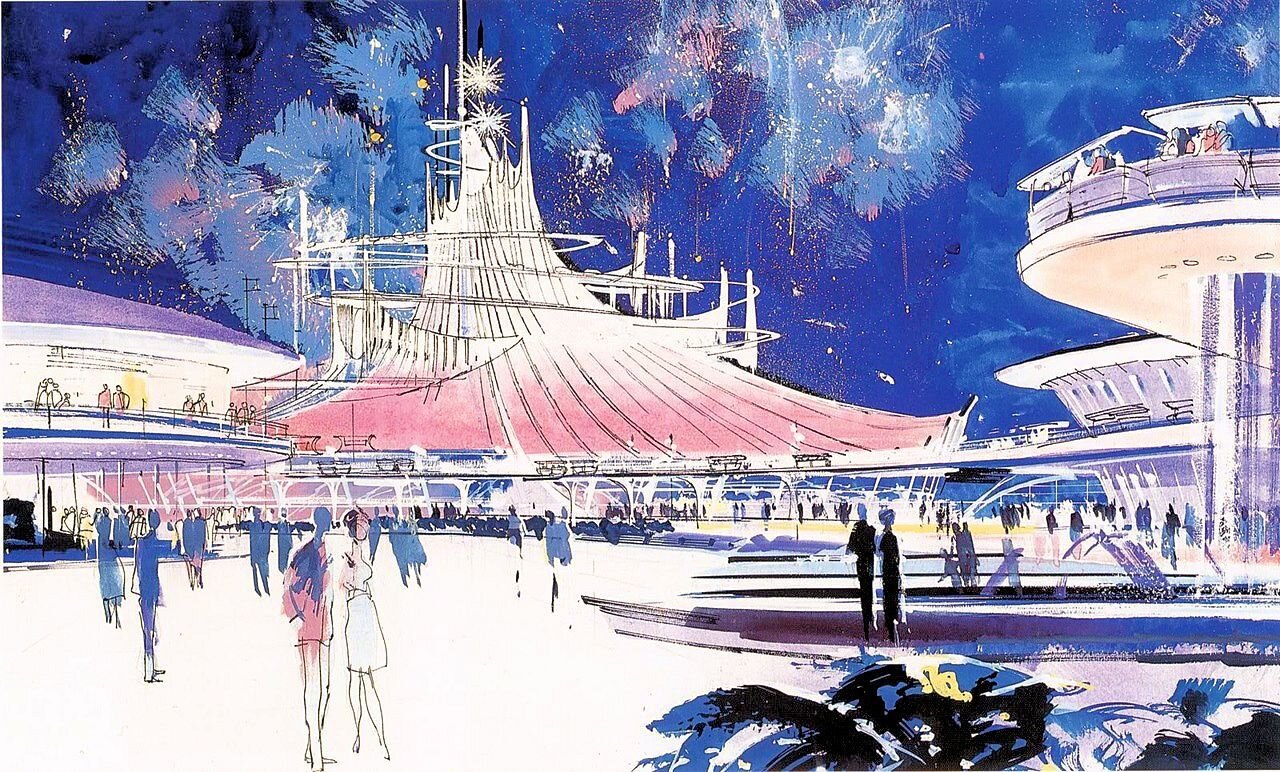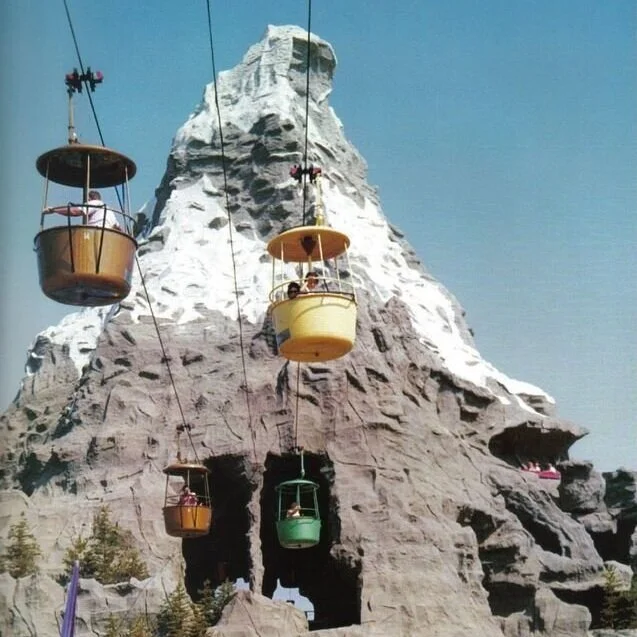E-Ticket: Space Mountain
Welcome back to my E-Ticket series! These are posts based on the E-Ticket magazines sold by the Walt Disney Family Museum, named after the original ticket you used to have to purchase during the opening months of Disneyland. Today we’re going to dive into the history of Space Mountain, and the imagineers who made it all happen.
The Nation’s most breathtaking thrill ride.
These were some of the very first words to describe the newest attraction coming to Florida’s Walt Disney World, announced in October of 1972. When the news broke, the original name of the ride was “Space Voyage”, and concept art was also released to get the crowds excited about it. The artwork shows all of the different levels the tracks would be on, how twisted each turn is, and the idea that we would be in spacecrafts flying around the planets. The concept art was made by John Hench, Clem Hall, George McGinnis, Herb Ryman and others. The first mention of the attraction by Walt was in 1964, more than a decade before the opening of it, but it was left on the sidelines while other projects progressed.
Image from: https://www.pinterest.ca/pin/524176844105403112/
Image from: https://www.navfile.com/walt-disney-world-resort/magic-kingdom/space-mountain/wait-time-ride-time-line-queue
As we all know, Walt was fascinated by the innovations the future could hold. He had already created Tomorrowland in his first park, Disneyland California, and wanted to continue the futuristic themes and expand in both parks. He wanted it to be an experience though, rather than just another amusement park ride, which is what he tried to avoid in every attraction he made. When he first had the idea of Disneyland, everyone told him it would be a failure given that amusement parks generally weren’t as popular as he wanted his park to be. A way around this was to create an environment around regular amusement park tracks, which is what he did with the Matterhorn Bobsleds. They used this same idea with Space Mountain, creating the dark surroundings to mask the heavy metal rails. While in construction for Space Mountain, in order to keep the attraction feeling like it was an experience rather than just another “ride”, they also worked and focused heavily on the queue of the ride too. They added many models, figures, and audio animatronics to further immerse yourself into outerspace.
OutersPace isn’t big enough for the two of us
As it was announced in 1972, they had just begun working on it. It covered 10 acres of land in Walt Disney World, with over 4.5 million cubic feet of interior space, and stands 183 feet tall. There are 72 concrete beams that hold the building up, as it isn’t just a regular rectangular building. If you’ve ever rode Space Mountain, you’d know that there are also 2 tracks within the ride. They nicknamed them Alpha (left) and Omega (right). Alpha is 3,196 feet long, while Omega is only 3,186 feet long. The top speed of the ride is 28 m.p.h and the duration is 2 minutes and 40 seconds.
Image from: https://disneyparks.disney.go.com/blog/2012/05/celebrating-35-years-of-space-mountain-at-disneyland-park/
Image from: https://www.pinterest.ca/pin/320248223474791612/
Given the fact that the Anaheim space wasn’t as large as the Florida one, they had to scale down the size of the original design tremendously. Florida’s 4.5 million cubic feet was everything compared to California’s 1.8 million cubic feet. However, to make up for this loss for the structure, they made the ride faster at 32 m.p.h and the tracks 3,450 feet in length. And, they added a double seat to each vehicle, so they could have more riders at one time.
Launch Days
Image from: https://gregmaletic.wordpress.com/2008/04/12/space-mountain-attraction-poster/
The attraction had its grand opening on January 15th, 1975. The very first rider of Space Mountain was Colonel James Irwin, “the pilot of the Lunar Module on the Apollo XV mission to the moon” (E-ticket, 1998). The ride was very successful and popular for the Florida park, and so only 6 months after opening, they began construction on Space Mountain in Disneyland in July of 1975.
The grand opening for Disneyland’s Space Mountain was on May 27th, 1977, and the theme of the space station was named after the opening year, Space Station 77. The first riders of this attraction were the first men into space, Captain Scott Carpenter, Colonel Gordon Cooper, Senator John Glenn, Captain Walter Schirra, Admiral Alan Shepard and Donald Slayton. They loved it and wanted to go again. I think this speaks volumes for the riders, now 43 years later, too.
This is a quote from the E-Ticket Magazine by Imagineer John Hench, speaking about how even though Walt wasn’t around for the construction and opening of the ride, it was Walt’s vision all along:
Walt didn’t call it Space Mountain at the time, but he felt we needed an attraction in Tomorrowland that would present the future through space travel. Walt had a prophetic ability and knowledge of how to bring different experiences together in a perfect blend, and he knew Space Mountain would be an attraction that would enrich the guest’s experience one step farther. We didn’t just build this because we needed another thrill attraction. Walt always intended this to be here, and we never abandoned the idea.









